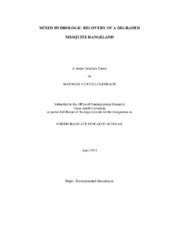| dc.description.abstract | Land degradation and anthropogenic change is widespread on rangelands in Texas. Over the last 150 years, noticeable change has occurred as a direct result of agricultural practices and human activity. As novel ecosystems and permanently altered landscapes become more common, an understanding of these new environments becomes essential. The ability of rangelands to rebound from past degradation is a factor of interest and one this study attempts to quantify. How a localized hydrologic cycle responds to disturbance can be indicative of the health of an ecosystem. This study characterized the hydrology of a mesquite rangeland at Fort Hood, Texas and assessed the current hydrologic regime compared to similar rangeland sites. The site at Fort Hood is unique because it has undergone recent high intensity vehicular traffic and low intensity grazing. Additionally, the site was cultivated until Camp Hood was established in 1942. Presented within this paper are the results of a series of seven large-scale rainfall simulations, which quantified the hydrologic variables present at the Fort Hood site. Variables of interest included infiltration, runoff, and sediment loads. Key quantitative findings of the study include: (1) Runoff values accounted for 28.7% - 64.9% of the total application of water applied to the plot. (2) Infiltration rates ranged from 15.1 mm/hr to 70.1 mm/hr at the site and (3) sediment loads ranged from 1.7 kg/ha to 4.2 kg/ha. These findings potentially indicate that the site has undergone a mixed recovery to its past hydrologic regime because erosion amounts are minimal, but infiltration rates are lower than comparable locations. This is important because it describes the ability of these landscapes to recover from past degradation. | en |


